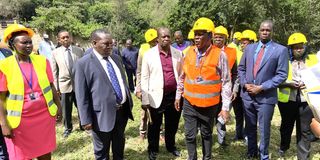State lays out plans to expand key waste facility

National Assembly Departmental Committee on Health chairman Robert Pukose and members, accompanied by officials of the Kenya Nuclear regulatory Authority tour the Central Radioactive Waste Processing Facility in Kajiado County.
What you need to know:
- Officials of the Kenya Nuclear Regulatory Authority (KNRA) said an estimated Sh350 million would be required to complete phase one of the Central Radioactive Waste Processing Facility station inside Oloolua Forest.
- Kenya generates between 3,000 and 4,000 tons of waste per day, with Nairobi alone contributing between 2,000 and 2,500 tons daily, including potentially radioactive materials.
The government has announced fresh plans to expand the country’s sole radioactive waste management facilities in Kajiado County.
Central Radioactive Waste
Officials of the Kenya Nuclear Regulatory Authority (KNRA) said an estimated Sh350 million would be required to complete phase one of the Central Radioactive Waste Processing Facility station inside Oloolua Forest.
Put up in 2010 and commissioned in 2022 by the government with the support of international partners, the station is the interim storage and processing installation for radioactive waste produced in Kenya.
The Departmental Committee on Health of the National Assembly and Public Health Principal Secretary Mary Muthoni recently toured the centre to ascertain its status. The facility also serves as KNRA’s national laboratory.
Funding request
Committee chairman Robert Pukose said the authority will appear before Parliament next week to put forward its funding request and table a breakdown of expected expenses towards finishing up phase one and starting phase two.
“We have toured the facility to understand what it does and would like to get further information in a week,” said Dr Pokose, who briefed the press on site after the tour.
KNRA Director General James Keter told MPs that radioactive waste is potentially hazardous and must be managed in safe ways that ensure the protection of the public and the environment.
“The completion and operationalization of Phase One of this facility will mark a significant milestone. Yet, to further bolster its efficacy, we now seek further funding to advance it into Phase Two,” Mr Keter said.
Kenya generates between 3,000 and 4,000 tons of waste per day, with Nairobi alone contributing between 2,000 and 2,500 tons daily, including potentially radioactive materials.
The committee’s visit was is in line with its mandate under House Standing Order No. 216(5) (b) to study the programmes and policy objectives of ministries and departments and the effectiveness of the implementation.
Nuclear technology
Some of the waste expected to be managed at the centre mainly come from medical facilities that use nuclear technology for treatment and diagnosis, agricultural research institutions, industrial activities and road construction.
Poor management of radioactive waste or radioactive pollution exposes the public to cancer. Other dangerous diseases that might occur include anaemia, leukaemia, haemorrhages, and cardiovascular diseases.
KNRA board chairman Omondi Anyanga said besides efforts to improve radioactive waste management, the regulator was exploring all options to ensure Kenya harnesses safe forms of nuclear and radiation applications, with safe disposal of waste taken care of.
“We are fully dedicated to upholding the Authority’s mandate. We pledge to do everything within our power to ensure that KNRA fulfills its obligations,” Mr Anyanga said.
Besides KNRA’s regulatory role of protecting lives and the environment from harmful effects of nuclear and radiation, the authority hosts the chemical, biological, radiological and nuclear (CBRN) risk mitigation center at the Oloolua facility.
Public safety and security
Experts say the use of radioactive sources and the quest to properly manage waste has brought with it some challenges that include the likelihood of the sources getting out of regulatory control and therefore posing a risk to public safety and security.





